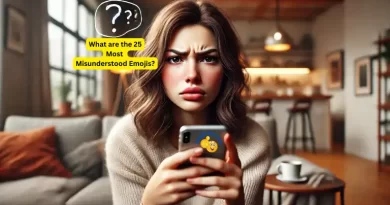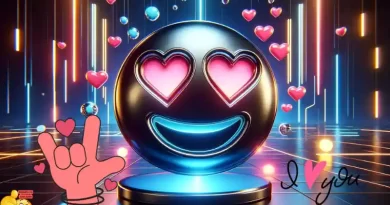Decoding the Impact of the Flipping Off Emoji 🖕
Have you ever fired off a quick text, punctuated with the flipping off emoji or middle finger emoji? 🖕 You’re not alone.
We all have those moments when words fall short. When we need something bolder to express our feelings. Something like…an emoji.
But how much do you know about these tiny symbols? About their origins, evolution, or impact on our culture?
This post is your deep dive into one of the most provocative ones: the flipping off emoji. We’ll explore its journey from creation to mainstream use and its role in digital communication.
You might just walk away seeing this audacious little symbol in a whole new light. Ready for an enlightening ride?
Table Of Contents:
- The Art of Digital Defiance: Understanding the Flipping Off Emoji
- Emojis as a Language: How the Flipping Off Emoji Conveys Emotion
- The Impact of Flipping Off Emoji on Social Media Platforms
- The Use and Misuse of Flipping Off Emoji in Digital Communication
- Pop Culture’s Influence on the Flipping Off Emoji Craze
- Decoding the Legal Implications of Using Flipping Off Emojis
- Funny Uses for Flipping Off Emoji
- Trends in Future Use – Where is Flipping Off Emoji Going?
- FAQs in Relation to the Middle Finger Emoji
The Art of Digital Defiance: Understanding the Flipping Off Emoji
Emojis, those colorful symbols we sprinkle throughout our digital conversations, have one standout star that screams defiance – the flipping off emoji. Known by many names like ‘middle finger’ or ‘fuck-off’, it’s a symbol not to be ignored.
A Brief History of the Middle Finger Emoji
Did you know this audacious icon wasn’t always part of our digital vocabulary? It only came into mainstream use with Unicode 7.0 in June 2014 after much discussion about its appropriateness and cultural acceptance.
This cheeky symbol quickly found its way from being an unrecognized glyph hidden deep within code strings to becoming a staple in text messages and social media posts worldwide. A fascinating journey indeed.
Cultural Interpretations and Controversies
The flipping off emoji isn’t without controversy; interpretations vary across different cultures leading to misunderstandings and conflicts. Some see it as just a funny way to express annoyance or frustration, while others perceive it as offensive language equivalent to saying ‘screw-you’.
Differences in societal norms regarding respectfulness can lead platforms like Apple initially refusing such explicit content due to their user base’s varied demographics.
- #Flipping-The-Bird: Used when strong feelings need expressing sans words.
- #Middle-Finger: Seen when people show disdain for someone else’s actions.
- #Fuck-You: When individuals wish to communicate anger explicitly.
- #Screw-You: During heated exchanges where users want to express contempt.
These hashtags associated with flipping off emojis reveal how they are commonly interpreted. To delve deeper, visit Instagram’s trending hashtag page here.
Even with the risk of misunderstandings, these emojis bring a new depth to our online chats. They let us blow off steam in short and sweet ways while giving us a vibrant way to express ourselves. The middle finger emoji is still going strong,
Emojis as a Language: How the Flipping Off Emoji Conveys Emotion
As we navigate through our digital world, emojis and emoticons have emerged as a vibrant new language. This unique form of communication breaks down linguistic barriers with vivid symbols that express emotions universally.
The middle finger or ‘flipping off’ emoji stands out among these symbols. It communicates complex feelings like anger or defiance more effectively than words alone can do.
Making Sense of Emotions Through Emojis
In text-based conversations, body language and tone are missing elements. We often rely on punctuation marks to interpret emotional undertones. However, when it comes to accurately expressing complex feelings, they fall short.
This is where emojis step in. The middle finger emoji, known for flipping someone off virtually, delivers an unmistakable message of displeasure or rebellion. Let’s explore how this icon adeptly conveys non-verbal cues within our modern emoticon language by replicating real-world gestures that most people instantly recognize regardless of their native tongue.
Trending Hashtags & Social Media Popularity
On social media, this particular symbol has become a hit with various age groups. In fact, hashtags associated with flipping off GIFs such as #emoji, #emoticon, and especially #middlefinger have gained substantial traction online due to their expressive power.
Tweets containing the middle finger emoji are typically characterized by strong sentiments – be it frustration towards a situation or outright hostility against another user.
Instagram posts tagged under these categories also demonstrate similar trends; users generally use them while expressing disdainful reactions toward something deemed annoying or unfair.
So why did this symbol resonate so much with users worldwide despite its seemingly negative connotation? Let’s find out.
Note: While using bold imagery like the flipping-off emoji can add flavor to our digital interactions, making them feel more authentic – remember not everyone might appreciate receiving such strong signals. So now that you
The Impact of Flipping Off Emoji on Social Media Platforms
Have you ever wondered how emojis, especially controversial ones like the middle finger, influence our online interactions? Well, it’s time to dig in. The use of such strong symbols is shaping social media dynamics and adding a new dimension to digital communication.
“Emojis have transformed text-based conversations by adding non-verbal cues. In heated debates or arguments, users often resort to aggressive symbols like the flipping off emoji for emphasis.”
In essence, these tiny graphical representations play an enormous role in expressing tone and intent during discussions. Emojis can help to prevent confusion which could come about due to the lack of physical contact.
The Role of Emojis in Online Arguments
Emoticons aren’t just about sprucing up messages; they serve functional purposes too. When words fail us during intense online disputes or when we want our feelings known without using explicit language – here comes #Emoji.
- #Bad-Gesture related GIFs make their way into chats as people seek clear messaging methods.
- Middle finger gifs are notably prominent among millennials’ personal chats despite the controversy surrounding them.
- ‘Flipping-off’ images even trend periodically across different regions, reflecting collective sentiment at certain points in time.
Social Media Interaction: A New Landscape Shaped by Emojis?
- Emojis have significantly impacted user engagement levels globally, providing quick ways for users to respond with minimal typing efforts – perfect for today’s fast-paced digital world.
- A study reveals frequent usage patterns among demographics where emoticons like #Screw-You feature prominently, indicating comfortability amidst controversies.
- Negative emoticons lead both the sender and receiver towards more negativity within conversation threads, according to research studies.
Wrapping up, it’s clear that content related to ‘Flipping Off’ has carved its own niche in pop culture. This just goes to show how emojis continue to hold sway.
Key Takeaway:
Emojis, particularly the provocative flipping off symbol, have evolved into potent tools for expressing tone and intent in digital communication. These visual cues are shaping social media dynamics, helping to prevent misunderstandings due to lack of face-to-face interaction. The popularity of such emoticons among millennials indicates their comfort with using these symbols amidst controversies.
The Use and Misuse of Flipping Off Emoji in Digital Communication
Emojis, those tiny symbols that add spice to our digital chats. But did you know some emojis are stirring up a storm? Yep, we’re talking about the flipping off emoji.
Sometimes playfulness can quickly become a source of tension when someone takes offense. The use or misuse of this cheeky little symbol can make conversations edgy or even lead to misunderstandings. Learn more here.
The Psychology Behind Using Controversial Emojis
Digging into why people opt for such controversial emojis is like opening Pandora’s box – psychology meets technology.
In one corner, we’ve got folks using these emoticons as an emotional release. You see this reflected in hashtags like #You-Me and #Vocês-Me-Cansam related to misuse of flipping off GIFs.
- Digital etiquette: Much like offline rules governing behavior, there should be guidelines for online interactions too (get your digital manners right).
- Cognitive aspects: Ever wondered how our brain processes emoticons? It could affect comprehension levels (more on cognition here). This knowledge might help improve communication efficiency online.
- Social implications: Before hitting send on potentially offensive symbols consider societal norms around acceptable behaviors (explore social considerations).
- User discretion: Everyone has different thresholds for what constitutes offense. Keep that in mind before sending out provocative emojis (know more).
Moving forward remember not just what you intend with an emoji but also how it could potentially be perceived by others.
In short – tread lightly when using any controversial emoji.
Pop Culture’s Influence on the Flipping Off Emoji Craze
In this digital age, our communication has evolved to include symbols and emojis. One such symbol is the flipping off emoji, which has become controversial but is widely used.
“This defiant gesture finds itself under pop culture’s spotlight. It divides opinion – some see it as crude, others embrace it as raw expression.”
Cinema: Shaping Emoji Trends
The role of film and television in shaping cultural norms extends to influencing emoji use as well. Blockbuster franchises like Guardians of the Galaxy popularize certain emojis by associating them with memorable scenes or characters.
“Peter Quill (Star-Lord) frequently uses defiant gestures which fans mimic online through flipping off GIFs.”
Television shows also significantly contribute to these trends. For instance, Kristen Bell utilized this bold symbol during her stint on ‘The Good Place’, causing ripples across social media platforms where viewers expressed similar sentiments using related GIFs.
“Pop culture plays an integral role not just in what we watch but how we communicate digitally afterwards – changing perceptions around controversial emojis over time.”
Digital Communication Riding On Pop Culture Waves
Movies and TV shows not only dictate which emojis become popular, but they also determine when specific symbols are used more frequently. Fandom communities rally behind hashtags associated with their favorite entertainment forms, collectively utilizing relevant emoticons following new releases or significant episodes.
A case study would be a surge in usage of flipping-off gifs after the release of each episode from a series featuring rebellious characters expressing displeasure through similar actions.
Trending topics revolving around contentious dialogues amplify this effect since users tend to pair them up with matching controversial emojis, establishing a strong correlation between cinematic content consumption patterns and corresponding shifts observed within contemporary textual exchanges.
Meme Culture: A Catalyst For Controversial Emojis?
Memes are undoubtedly a major factor in modern-day discourse and culture, influencing conversations to an unprecedented degree.
Key Takeaway:
Pop culture’s grip on digital communication is unshakeable. Movies and TV shows have the power to popularize emojis, with rebellious characters often driving a surge in usage of defiant symbols like the flipping off emoji. Memes also fuel this trend, serving as catalysts for controversial emojis that mirror our society’s shifting norms.
Decoding the Legal Implications of Using Flipping Off Emojis
As our digital realm continues to advance, we have come up with novel ways of expressing ourselves. One such innovation is emojis – fun little symbols that encapsulate an emotion or idea in a single icon. Yet some carry more weight than others, like the ‘flipping off’ emoji.
“In many cultures, showing someone your middle finger is seen as disrespectful and offensive.”
But what happens when this gesture enters the realm of cyber law? And how does it tie into pop culture phenomena like #The-Ranch?
Navigating Cyber Law with Controversial Emojis
The legal landscape can get tricky when these tiny icons come into play because context becomes key in interpreting messages laced with potentially offensive emojis.
“Consider Netflix’s series #The-Ranch, where characters often engage in text banter involving flipping off GIFs.”
This scenario might be humorous among friends but could become contentious if shared without mutual understanding or consent.
- Different jurisdictions may interpret sending a ‘flipping-off’ emoji differently under local cyber laws – especially if sent repeatedly or with malicious intent.
- If you find yourself embroiled over an offending emoji sent during online interaction – whether through social media platforms (#Ranch), messaging apps, etc., consulting a lawyer well versed in both traditional and cyber law would provide guidance based on your specific situation and jurisdiction.
- Avoidance remains best though. Understand that even something seemingly trivial as sending controversial emojis could land you in trouble – practicing responsible digital citizenship includes being mindful of respect across all languages – including those spoken digitally.
Funny Uses for Flipping Off Emoji
Have you ever considered the flipping off emoji as more than just a symbol of defiance? With a touch of humor and creativity, you can transform this traditionally offensive digital icon into something downright amusing. Let’s explore some entertaining ways to incorporate this gesture into your chats.
Getting Creative With Your Middle Finger Emoji
Finger humor, anyone? The trick lies in the unexpected use. For instance, if someone cracks an outlandishly silly joke during a chat, respond with the middle finger emoji instead of the typical laughing face – it’s like saying “No way. You’re joking, right?” This unconventional usage adds an element of surprise and fun that enhances digital humor.
Picture this: You send a snapshot savoring ice cream on a sunny day captioned “Wish you were here” followed by our star emoticon – yes, the flipping off one. It would create such ironic hilarity because after such a sweet sentiment, one might expect hearts or smiley faces.
Memes and Emojis: A Match Made in Digital Humor Heaven
Memes offer another fantastic platform where flipping off emojis find their humorous stride. They provide visual context that helps us reinterpret these symbols not as offensive but funny.
A trend often seen online is memes featuring celebrities pulling goofy faces accompanied by captions like “#Did-You-Just-Flip-Me-Off?” along with said emoji – acting shocked at such audacious disrespect from our favorite stars.
Tips:
- Add fresh twists to old jokes using unusual emojis.
- Catch people unawares with random flips during casual chats – remember though, its sense of humor may not be everyone’s cup of tea.
- If used cleverly yet sparingly, even negative connotations could turn into conversation starters.
And that’s a wrap, everyone. We’ve transformed something once seen as off-limits into hilarious gems, all thanks to innovative thinking and the power of social media.
Key Takeaway:
Who said the flipping off emoji was only for defiance? Turn it into a humor tool with unexpected uses. Use it as a punchline to an outrageous joke or sprinkle it in casual chats for surprise laughter. Remember, this is not everyone’s cup of tea – so use wisely. Memes and emojis can create digital humor heaven when combined creatively.
Trends in Future Use – Where is Flipping Off Emoji Going?
Emoticons and smileys have transformed the way we communicate online. Among these, one emoji that’s been turning heads lately is the flipping off emoji.
The digital world has opened up a vast arena for expressing ourselves more creatively and assertively. One such bold expression tool that’s been gaining popularity recently is the flipping off emoji.
Riding High on Expressive Emojis
With conversations increasingly moving towards text-based platforms, there’s a rising demand for non-verbal communication tools like emojis to convey our emotions effectively. As social norms around digital etiquette continue to evolve, controversial yet expressive symbols like the flipping off sign are finding their place within certain contexts.
And it doesn’t stop here. The trend of using such edgy emoticons isn’t limited just to younger audiences anymore; people across different age groups are embracing this unique form of self-expression when words aren’t enough or simply fail.
Societal Acceptance Fuels Usage Patterns
In fact, according to an analysis by EmojiTracker, this particular emoji’s usage might be set for even higher growth due to its ability to succinctly express strong sentiments – adding value beyond traditional textual content.
Navigating Digital Communication Etiquette with Bold Emojis
Digital communication evolves rapidly, and alongside this evolution comes changes in what’s deemed appropriate or inappropriate behavior. The inclusion of assertive symbols like the flipping-off emoji presents new challenges but also opportunities for enhancing emotional expressivity.
These unique ways of showing feelings are becoming more common, signaling a shift in society’s acceptance as part of our online chats. As they become more normal, it looks like we’ll see them even more in future trends.
Key Takeaway:
Emojis are shaking up how we chat online, and the flipping off emoji is becoming a go-to for gutsy self-expression. It’s getting more popular among all age groups, showing that digital manners are changing and society is cool with these expressive icons. So get ready – this daring little symbol isn’t just sticking around; it’s gearing up to rule our future digital chats.
FAQs in Relation to the Middle Finger Emoji
What does the middle finger emoji mean?
The middle finger emoji, also known as flipping off or giving the bird, is a digital symbol of disrespect and defiance.
Is it appropriate to use the flipping off emoji in professional communication?
No. The usage of controversial emojis like the middle finger is considered unprofessional and disrespectful in business communications.
Can using offensive emojis have legal implications?
Potentially yes. In certain cases, using offensive emojis can be viewed as harassment or a threat, which could lead to legal consequences.
How has pop culture influenced our usage of the flipping off emoji?
Movies and TV shows often incorporate this gesture into their narratives, leading audiences to adopt its usage more widely in their own digital conversations.
Are there any funny uses for the flipping off emoji?
Certainly. With creativity, you can turn an otherwise offensive symbol into something humorous that lightens up your chats.




